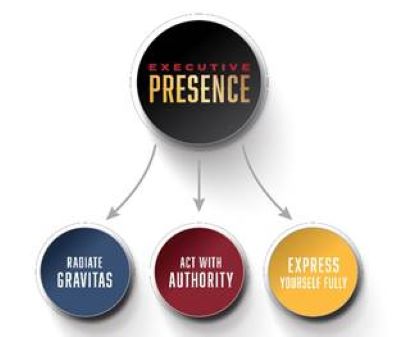Understanding Executive Presence – Gravitas, Authority, & Expression
Three central elements imbue a leader with executive presence. Understanding them fully will allow you to cultivate each one. This will demystify what executive presence is and help you create a development plan for growing it.
3 Domains of Executive Presence
So, what are these three elements? I’m referring to the three domains of executive presence that I outline in my 3×3 Executive Presence Model:
- Gravitas
- Authority
- Expression
This model provides a framework for understanding executive presence. You can view gravitas as who you are, authority as what you do, and expression as what you say. To understand executive presence, you need to know what each of these elements means and what it looks like in practice. Let’s take a birds-eye view of each one of them now.

Gravitas
-
The 1st Element to Understanding Executive Presence
Gravitas is the powerful presence a leader with executive presence exudes. What does this look like in action? These leaders command a room effortlessly, even if they speak quietly. People want to be in their presence and hear what they have to say. This magnetic power and presence stems from their confidence, ability to be in command, and charisma. They inspire people, make them feel good about themselves and the work they’re doing together, and command respect.
The gravitas such leaders possess guides people to instinctively trust them. They radiate capability even in the most challenging situations. And their charisma guides them to effectively motivate people.
Whether in front of a crowd or at a team meeting, these leaders are poised. If faced with a tough situation, they radiate calm and capability. They maintain an inner self-belief in their ability to guide the team through stormy waters.
Leaders Lacking Gravitas
Conversely, leaders who lack gravitas may come across as lacking confidence, flappable, uninspiring, too quiet, or easygoing. They may seem like a pushover, lack passion for what they do and say, and stay on the sidelines rather than stepping into the spotlight. As a result, people don’t trust their ability to lead.
Leaders Growing Gravitas
Such leaders need to tap into what fills them with purpose and build the confidence to drive a team to success. As they exude enthusiasm for the vision they’re working to fulfill, they’ll inspire others. And as they gradually tap into their strengths and expand their confidence, they’ll feel more equipped to seize opportunities to lead. In turn, they’ll come across as more commanding and capable.
Authority
-
The 2nd Element to Understanding Executive Presence
Authority is what leaders do and how they act—the impact they make. Leaders with authority are decisive, bold, and influential. They trust their intuition and make decisions with certainty, putting a stake in the ground and defending their position. They share controversial opinions and outside-of-the-box ideas. And they effectively persuade others and guide them toward action, exerting influence throughout their organization. Their powerful aura of authority leads others to defer to their judgment.
Leaders Lacking Authority
In comparison, leaders who lack authority may appear indecisive, timid, unconvincing, and weak. They also may not be accountable for their actions, since they don’t truly own them. Because they don’t put a stake in the ground and defend a position or see a decision through, they may feel and act less responsible for outcomes. Such leaders need to practice making and defending choices rather than always deferring to others. They must also practice voicing ideas boldly and crafting persuasive arguments.
Expression
-
The 3rd Element to Understanding Executive Presence
Leaders with executive presence are vocal, insightful, and clear. With their impressive powers of expression, they articulately explain their viewpoints in a way others can easily digest. They participate actively in discussions, share well-developed ideas, and ensure others have understood them. People appreciate their intelligent contributions and always want to listen when they speak.
Leaders Lacking Expression
In contrast, leaders who lack expressive abilities may be either too quiet or longwinded, difficult to understand, unpolished and unprecise in their speech, and lacking knowledge. People have difficulty understanding what point they’re trying to make, as they don’t put the most crucial information front and center.
Leaders Improving Expression
To correct course, these leaders need to schedule time to prepare their thoughts before meetings rather than rushing from one to the next. This will help them become both more vocal and more clear. Spending time reflecting on ideas will also help them make more insightful contributions. When delivering presentations, they should rehearse in front of another person to gain feedback.
These qualities are all mutually reinforcing. For instance, speaking clearly will enhance a leader’s decisiveness, whereas rambling will undermine it. Being vocal is essential to growing influence.
For a more in-depth understanding of executive presence, I highly recommend reading my book Executive Presence: Step into Your Power, Convey Confidence and Lead with Conviction, where I thoroughly outline the 3×3 Executive Presence Model.
Enlist the help of a skilled executive presence coach to develop all three main elements of executive presence. Contact Joel for one-on-one guidance on becoming a leader who communicates skillfully, radiating executive presence in all situations. You can browse through his numerous articles on executive presence. You can also bring him into your company for an executive presence training program or purchase his book for your employees, Executive Presence: Step into Your Power, Convey Confidence and Lead with Conviction.
|
